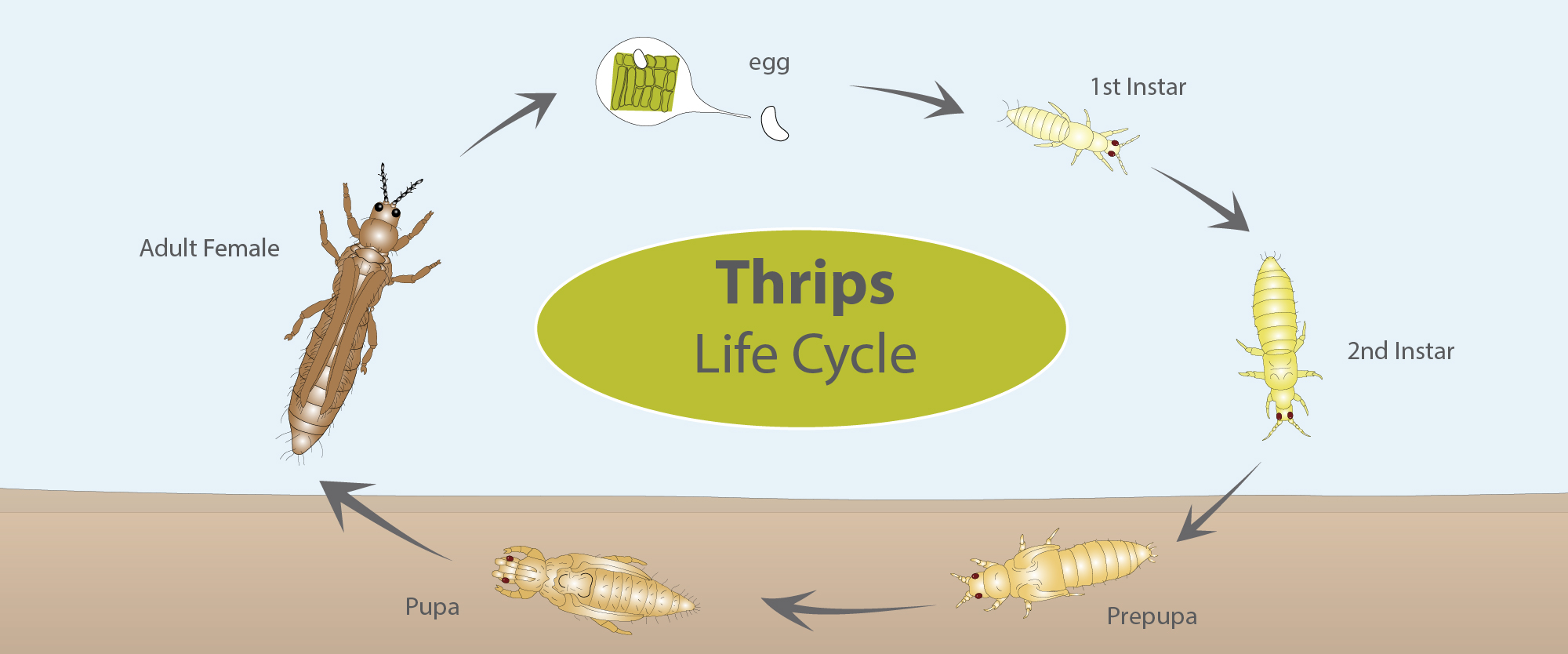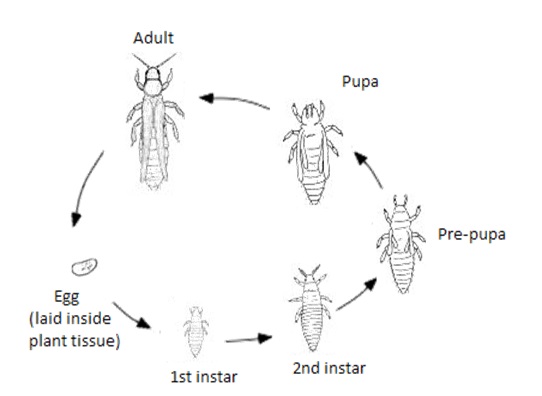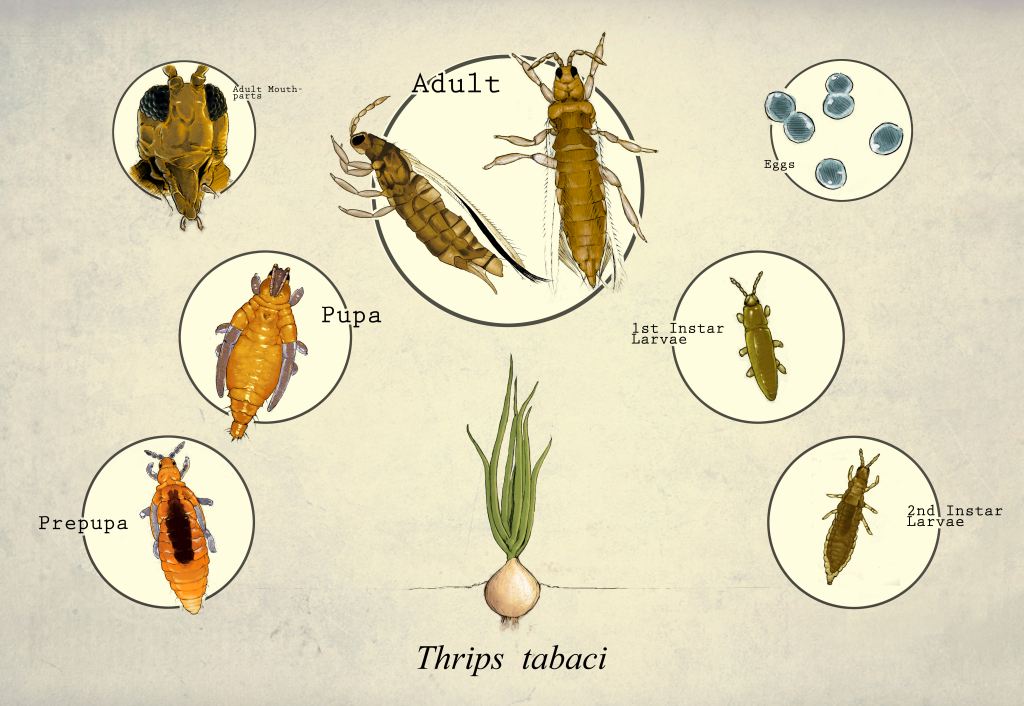onion thrips life cycle
This video show the life cycle of onion thrips which has six life stages egg first and second nymph pre pupa pupa and adult with images. The thrip life cycle takes approximately 2 weeks completes and consists of an egg stage a feeding larval stage non-feeding prepupal and pupal stages and finally an adult stage.
Thrips In Greenhouse Crops Biology Damage And Management
Pupae and prepupae overwinter in the soil.
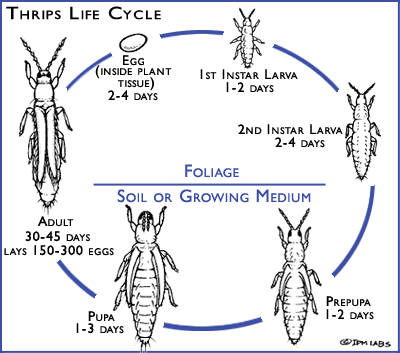
. Life cycle and appearance of Onion thrips Onion thrips Thrips tabaci develops in six stages. Egg two larval instars prepupa pupa and finally the adult insect. Egg larval prepupal pupal and adult.
Two larval stages require about 6 days for completion. These eggs hatch after 35 days and the nymphs then feed for 13 weeks before resting to molt in 12 weeks. Adults and larvae overwinter in the soil or plant litter on the ground.
Female adult western flower thrips live up to 30 days and lay 2-10 eggs per day. An Introduction to Thrips Variations in the length of each life stage occur between thrips species but in general. Offspring per cycle 20 to 50.
Onion thrips develops on leaves of a great many kinds of plants including many common weeds and vegetable crops. When the weather is warm the life cycle from egg to adult may be completed in as short a time as 2 weeks. The duration of thrips life cycles is determined by temperature.
Many times females greatly out-number the males in a population and parthenogenesis occurs. Thrips can be monitored using yellow sticky paper and controlled with the help of natural predators proper weed management plant covers and reflective mulch. Key thrips lifecycle facts.
Eggs hatch after 5-10 days and nymphs are full grown within 15-30 days. Onion thrips Thrips tabaci develops in six stages. Population increase occurs at its peak during April-May.
After two molts the larva enters the pre-pupal stage lasts about 1 day during which wing buds are developing externally. Adults insert their eggs into plant tissues. Young thrips lack wings but adult thrips have four wings that are very narrow and fringed with hairs.
Thrips have an unusual life cycle that starts with hatching from an egg and then going through two feeding larval stages followed by two non-feeding stages called the pre-pupa and pupa. Then the prepupal and pupal stages take an additional 4 days. At 25C it takes 13 days.
Females can reproduce without mating and lay eggs beneath the leafs surface. Eggs inserted into the plant tissue by the females sharp egg-laying tube ovipositor hatch in about 6 days. The first two thrips nymphal stages feed on plants.
In the thrips life cycle egg-to-adult development takes about 16 days. Type of reproduction sexual male female oviparity egg-laying In exceptional cases asexual parthenogenesis and live birth. Thrips adults are capable of flight and are likely assisted for longer range dispersal by air currents.
Thrips on garden plants usually have two or three generations a year but may have more during hot summers. Then the prepupal and pupal stages take an additional 4 days and generally occur in the soil. Development stages of thrips include eggs two nymph stages pre-pupa pupa and adults.
Eggs hatch after five to 10 days. The eggs of the onion thrips Thrips tabaci are laid in leaves flower petals and in the soft parts of stalks. Females deposit eggs directly in the host tissue.
Onion thrips Scientific Name. Life cycle and appearance of Onion thrips. Females can reproduce without mating and lay eggs on the undersides of leaves.
Onion thrips overwinter in legume and grain fields and along weedy field edges. An egg two larval stages a prepupal and pupal stage and an adult. These thrips have six stages in their life cycle.
They become active during warm days in spring and are present until cold weather in Fall. The egg will normally hatch within a couple of days after being laid and the stage that follows Instar I. Females may lay 80-30 eggs depending upon species host and temperature.
Thrips have several generations up to about eight a year. Onion thrips have six to ten generations depending on temperature. In the thrips life cycle egg-to-adult development takes about 16 days.
Egg two larval instars prepupa pupa and finally the adult insect. The duration of each development stage is temperature dependent. Active during daytime.
THRIPS LIFE CYCLE. Thrips can have up to 15 generations per year outdoors. Generation time varies with temperature and the species but generally takes about a month.
The life cycle consists of five stages. Identification and life cycleseasonal history Onion thrips Thrips tabaci spend the winter as an adult in protected areas such as under plant debris. They are inserted into the plant tissue with a saw-like ovipositor.
The eggs of the onion thrips Thrips tabaci are laid in leaves flower petals and in the soft parts of stalks. Most species insert eggs into plant tissue and most species pupate in or on soil. Eggs inserted into the plant tissue by the females sharp egg-laying tube ovipositor hatch in about 6 days.
Thrips feeding on plants can damage fruit leaves and shoots and. Generations per year up to 40. Outdoor thrips overwinter as adults or nymphs either in the soil or concealed on the host plant.
Females deposit 100 to 200 eggs. Thrips lifespan 45 days as an adult not including hibernation. Thrips tabaci Lindeman Order.
Regarding the life cycle of these thrips eggs are inserted into plant tissues. Two larval stages require about 6 days for completion. At 20C development from egg to adult takes approximately 19 days.
Thrips pass through six developmental stages. Shortest during of life cycle have been recorded during April about 14 days and longest in December about 23 days. Females can reproduce without mating parthenogenesis thrusting bean shaped eggs completely into leaf and stem tissue.
Adult females and nymphs occur throughout the year on and around host plants. Life cycle is completed in 11 to 21 days. Under ideal conditions the life cycle is completed in 24-35 days and thrips in glasshouses may continue breeding throughout the year.
They may lay eggs inside plant tissue underside of the leaves inside flowers or along the stems. Wingless males are rare. Onion thrips overwinter in legume eg alfalfa and grain eg wheat fields in weedy areas and in onion bulbs not removed from onion fields.
Onion thrips flights are more common in spring and autumn. Larvae emerge and begin to feed on the plant. The adults can range from a pale yellow to dark brown and are usually smaller than 116 of an inch.
The egg two larval instars two pupal instars and the adult stage. At 15 C a life cycle from egg to adult may take 35-45 days whereas at 30 C a life cycle can be completed in 12-15 days. Thrips also will feed on pollen.
They become active in early spring and lay eggs in plant tissue. Immature onion thrips are small and milky white at first and after molting turn to green or lemon-yellow with red eyes.

Thrips Life Cycle Thrips Control Thrip Killer
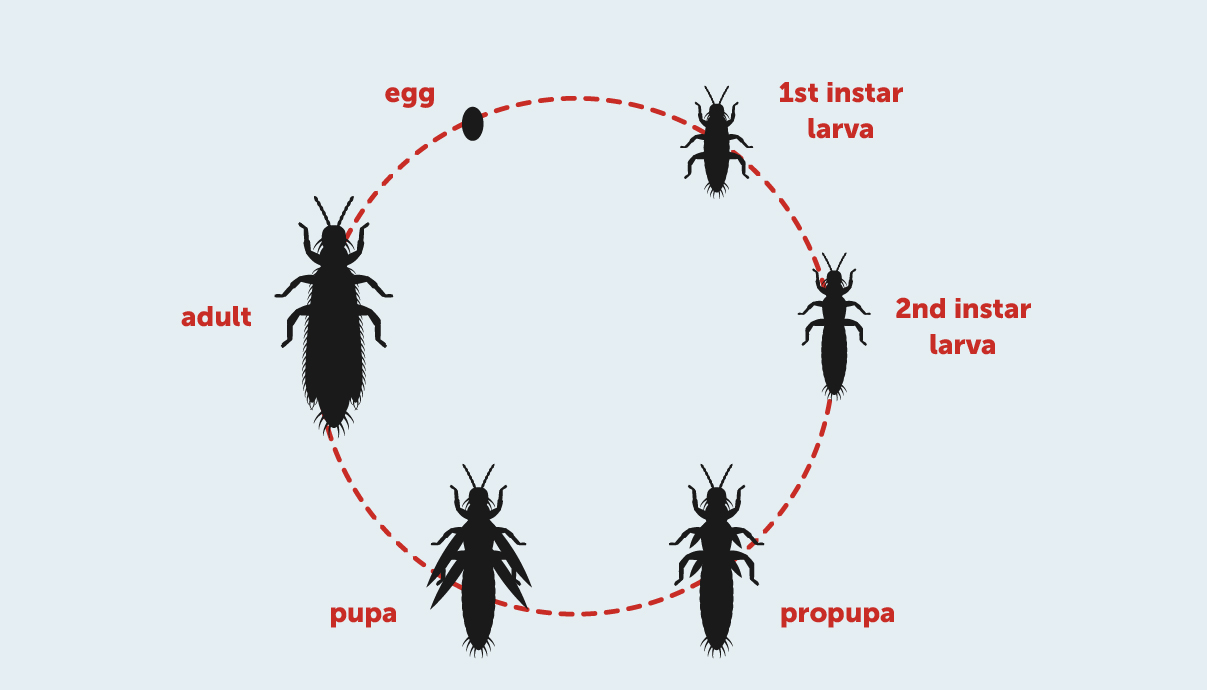
Cannabis Pests Thrips Growdiaries
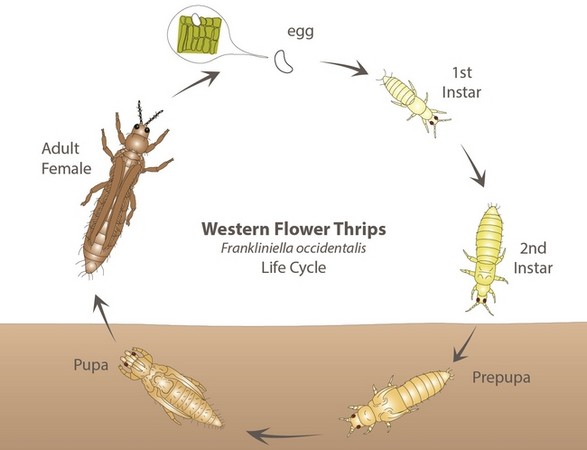
Integrated Pest Management Options For The Western Flower Thrips In Lettuce

Thrips Management Alternatives In The Field Semantic Scholar

Critters Down Under Thrips Pro Mix Greenhouse Growing

Life Cycle Of Onion Thrips Youtube

Complete Life Cycle Of Onion Thrip Of 1 Year Download Scientific Diagram

Thysanoptera An Overview Sciencedirect Topics

Biology And Management Of Thrips Affecting The Production Nursery And Landscape Uga Cooperative Extension

Feeding Damage Caused By Onion Thrips T Tabaci Photograph By Joseph Download Scientific Diagram
